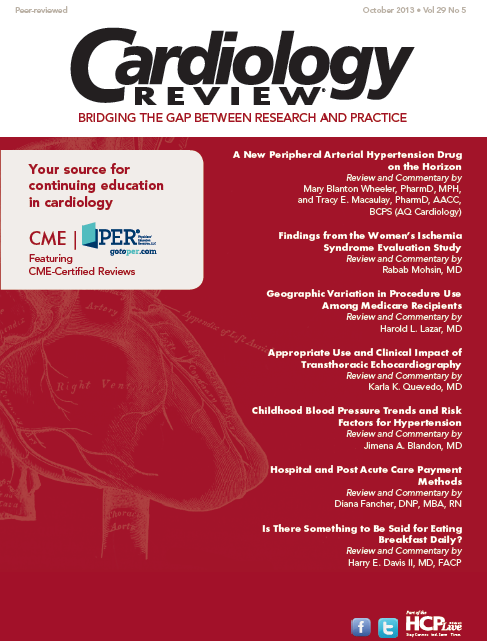Breakfast's Benefits and Much More for Autumn Reading
Debabrata Mukherjee, MD, MS, FACC
Editor-in-Chief
As winter comes knocking on our doors, I hope you will find time to relax with a cup of coffee and enjoy your copy of Cardiology Review. This issue of the journal discusses many important articles and viewpoints that I am sure you will find useful and enjoyable reading. October was an eventful month in our country, with the opening of the health insurance exchanges, which are a cornerstone of President Obama’s Affordable Care Act. The White House expects 7 million uninsured people to sign up for health insurance during the 6-month enrollment period, which would make a meaningful difference in many lives.
In this issue of Cardiology Review, Dr. Harry Davis discusses the importance of a daily breakfast and sets out to examine the potential for an increased risk of coronary heart disease because of skipping breakfast. He suggests that this study has reconfirmed the likelihood that dietary patterns, especially with regard to the potential for positive health effects of eating breakfast, are very likely important. He goes on to say that clinicians can now recommend to their patients eating breakfast every day, both to improve health and to potentially reduce mortality risks.
Dr. Karla Quevedo discusses appropriate use criteria and impact on transthoracic echocardiography use and reports that the use of appropriate use guidelines should be a continuous process, and its proper application by all physicians should be encouraged in inpatient and outpatient settings. Dr. Rabab Mohsin reports on findings from the Women’s Ischemia Syndrome Evaluation Study and notes that although we have made great strides by quantifying stenosis severity and looking at adverse outcomes in women with no coronary artery disease (CAD) or non-obstructive CAD, there need to be larger data groups comparing gender management and diagnostics.
Dr. Harold Lazar discusses geographic variation in procedure use among Medicare recipients and suggests that the increased numbers of catheterization laboratories and cardiovascular specialists in local regions has undoubtedly increased the incidence of these procedures. However, only by knowing the true incidence of clinical events can we determine whether these procedures are being over- or underutilized. Drs. Mary Wheeler and Tracy Macaulay review the role of the new peripheral arterial hypertension (PAH) drug riociguat, a novel guanylate cyclase stimulator agent. They comment that riociguat serves as a reasonable first-line alternative to PDE-5 inhibitors for PAH WHO functional class II or III, or in combination therapy with an endothelin antagonist or inhaled prostacyclin analogs.
Dr. Jimena Blandon looks at childhood blood pressure trends and risk factors for hypertension and reports that blood pressure is progressively increasing at very young ages, which can pose a threat of potential target-organ damage in the long term. She opines that we must all get involved in our children’s diet, physical activity levels, habits, and health care before it is too late!
Dr. Diana Fancher touches on an important issue for physicians: hospital and post acute care payment methods. She points out that available data today demonstrate the need to collaborate and integrate care in order optimize patient outcomes. This strengthens the argument for bundling payments and the need to incorporate well-planned care transitions for patients moving from the acute care setting to post acute state.
For our Diabetes section, Dr. Aparna Bhagavat muses on gliptins in the treatment of type 2 diabetes mellitus (T2DM), and suggests that the gliptins have a promising role in the control of T2DM, decreasing A1C without hypoglycemia or weight gain and without obvious adverse effect on cardiovascular outcomes. She concludes that gliptins appear to be safe in the T2DM elderly population, and it will be really interesting to see the outcomes of these drugs on newly diagnosed T2DM patients with no previous cardiovascular effects after a follow-up of 5 to 10 years. Also, the compilation of major studies presented at the recent European Society of Cardiology meeting by our insightful and talented managing editor, Ms. Jackie Syrop, should keep you updated on the latest happenings in this field.
I hope that you will find these commentaries to be valuable and enjoyable. I encourage you to share your insights, thoughts, and personal experiences on the topics touched upon in this issue. I would love to hear feedback on how we can make this journal even better. My goal continues to be to make you look forward to every issue of Cardiology Review.
Debabrata Mukherjee
Editor-in-Chief
